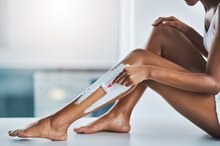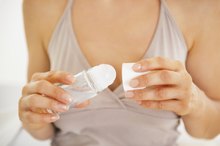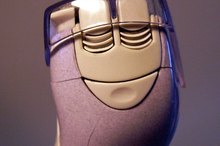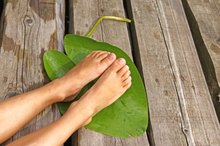What does fact checked mean?
At Healthfully, we strive to deliver objective content that is accurate and up-to-date. Our team periodically reviews articles in order to ensure content quality. The sources cited below consist of evidence from peer-reviewed journals, prominent medical organizations, academic associations, and government data.
The information contained on this site is for informational purposes only, and should not be used as a substitute for the advice of a professional health care provider. Please check with the appropriate physician regarding health questions and concerns. Although we strive to deliver accurate and up-to-date information, no guarantee to that effect is made.
Bicycles & Pilonidal Cyst Pain
A pilonidil cyst is a sometimes painful cyst that is almost always found at the top of the cleft of the buttocks near the tailbone. When the cyst — typically a small depression or pocket — becomes infected, it causes significant discomfort when you sit or place pressure on it. For those who love to cycle or who rely on a bike for transportation, a pilonidal cyst poses a significant obstacle 1.
Pilonidal Cyst Formation
A pilonidal cyst involves a hair buried under the skin and surrounded by a cyst 1. It may be caused when pressure or friction causes a loose hair to penetrate and work itself down into the skin. Biking, walking, sitting for long periods of time, tight clothing or skin pressing against skin might contribute to pressuring the hair into the skin. Once the hair has penetrated beneath the surface of the skin, the body responds as if it has been invaded by a foreign object, creating a cyst, or abscess, around the hair.
- A pilonidal cyst involves a hair buried under the skin and surrounded by a cyst 1.
- It may be caused when pressure or friction causes a loose hair to penetrate and work itself down into the skin.
Pilonidal Cyst Symptoms
How to Treat Acne Cysts
Learn More
Often, pilonidal cysts are symptom-free, presenting with only a small lump at the top of the cleft of the buttocks. Symptoms develop when the cyst becomes infected. If the cyst becomes infected, symptoms can include:
- pain
- reddening of the skin
- localized swelling
- drainage of pus or blood
- a foul odor
- a hair protruding from the cyst
Less commonly, you may develop a fever. The discomfort can disrupt routine activities such as sitting or walking.
- Often, pilonidal cysts are symptom-free, presenting with only a small lump at the top of the cleft of the buttocks.
- If the cyst becomes infected, symptoms can include: * pain
* reddening of the skin
* localized swelling
* drainage of pus or blood
* a foul odor
* a hair protruding from the cyst Less commonly, you may develop a fever.
Pilonidal Cyst Treatment
Uninfected pilonidal cysts don’t cause aversive symptoms and are often left untreated. Infected pilonidal cysts, however, can be difficult to ignore. Initial treatment includes using antibacterial soap to keep the affected area and the crease of the buttocks clean. If you have symptoms, consult your physician, who might prescribe antibiotics to help control the infection. You can also use an alcohol swab several times a day to reduce bacteria and manage the infection. If the symptoms persist or cause too much discomfort your doctor may perform outpatient surgery to drain or remove the cyst.
- Uninfected pilonidal cysts don’t cause aversive symptoms and are often left untreated.
- If the symptoms persist or cause too much discomfort your doctor may perform outpatient surgery to drain or remove the cyst.
Cycling Effect on a Pilonidal Cyst
Symptoms of an Infected Ingrown Hair
Learn More
Bicycling may or may not cause additional discomfort, depending on the precise location of the cyst and how you position yourself on the seat. Most people typically sit with the bony part of the bottom on a bike, placing pressure below the area of the pilonidal cyst 1. If you have discomfort when riding a bike, heed the pain and avoid applying pressure to the cyst. If the cyst causes enough discomfort to disrupt your bicycle riding, consult your doctor. You might be a good candidate for outpatient surgical treatment of the cyst.
- Bicycling may or may not cause additional discomfort, depending on the precise location of the cyst and how you position yourself on the seat.
- If the cyst causes enough discomfort to disrupt your bicycle riding, consult your doctor.
Split Saddle Seat
If you want to avoid exacerbating symptoms of a pilonidal cyst or want to reduce the risk of developing further cysts, you may purchase a split-saddle seat for your bike to reduce pressure 1. These saddle seats have plenty of padding and a split down the middle, and can provide comfort to those who have pilonidal cysts, hemorrhoids or other conditions that make it uncomfortable to sit on a bike seat.
Related Articles
References
- MedlinePlus: Pilonidal Cyst
- U.S. National Library of Medicine: MedlinePlus. Surgery for pilonidal cyst. Updated May 7, 2020.
- American College of Colon and Rectal Surgeons. Pilonidal disease.
- Onder A, Girgin S, Kapan M, et al. Pilonidal sinus disease: risk factors for postoperative complications and recurrence. Int Surg. 2012;97(3):224‐229. doi:10.9738/CC86.1
- Bendewald FP, Cima RR. Pilonidal disease. Clin Colon Rectal Surg. 2007;20(2):86-95. doi:10.1055/s-2007-977486
- Stauffer VK, Luedi MM, Kauf P, et al. Common surgical procedures in pilonidal sinus disease: A meta-analysis, merged data analysis, and comprehensive study on recurrence. Sci Rep. 2018;8(1):3058. doi:10.1038/s41598-018-20143-4
- American College of Surgeons. Medication and surgery: before your operation. Updated May 2019.
- Milton S. Hershey Medical Center. Surgery for pilonidal cyst. Updated May 27, 2019.
- George Washington University Medical Faculty Associates. Post-operative instructions for pilonidal excision.
- Oram Y, Kahraman F, Karincaoğlu Y, Koyuncu E. Evaluation of 60 patients with pilonidal sinus treated with laser epilation after surgery. Dermatol Surg. 2010;36(1):88-91. doi:10.1111/j.1524-4725.2009.01387.x
- Benedetto AV. Commentary: hair and pilonidal sinus disease. Dermatol Surg. 2010;36(1):92-93. doi:10.1111/j.1524-4725.2009.01388.x
Resources
Writer Bio
Jon Williams is a clinical psychologist and freelance writer. He has performed, presented and published research on a variety of psychological and physical health issues.








